Anyone who’s a fan of colorful freshwater fish has likely come across the paradise fish (Macropodus opercularis).

With their vibrant rainbow scales, they add a pop of color to any tank. And those trailing fins are the right touch of exotic.
Members of the Osphronemidae family, paradises share similar features and habits to other gouramis and the infamous betta.
This means they possess a labyrinth organ that allows them to breathe air at the surface. And the males build bubble nests during spawning season.
With brilliant red, blue, and green stripes, they stand out in any freshwater tank.
You’ll also see dark metallic spots that catch the light and shine. And they finish with a flick of their orange tails. It’s a complete rainbow that embodies the name “paradise.”
And while paradise fish – or paradise gouramis – are popular acquisitions, they’re also challenging to handle.
They have aggressive temperaments that make them a challenge to set up within communities. You’ll also need to make sure you’re up to their demanding water condition needs.
At a Glance
| Tank Size: | 20 gallons (76 l) |
| School Size: | usually best kept alone |
| Temperature: | 68-82°F (20-28°C) |
| Lifespan: | 8-10 years |
| Size: | 2-2.5 inches (5-6.4 cm) |
| pH: | 5.8-8.0 |
| Hardness: | 5-30 dH |
| Ammonia: | 0 ppm |
| Nitrite: | 0 ppm |
| Nitrate: | 0 ppm |
In this article
In the Wild

Paradise fish inhabit slower water systems throughout Southeast Asia.
You’ll find them in the Yangtze and Pearl Rivers of China, throughout Laos, Cambodia, and Malaysia, and up to Japan, Korea, and Vietnam. They also stretch east to India and Pakistan!
With the labyrinth organ allowing them to “gulp” air at the surface, they have no problem surviving in places other fish wouldn’t tolerate. This includes blackwater rivers, irrigation canals, rice paddies, and even shallow ditches.
The waters often experience different ranges of pH and temperature, and paradises adapt with little problem.
But they prefer areas with a heavy amount of plant cover. The foliage allows them to hide from predators and provides the vegetable matter for their diet.
Goldfish often rank as some of the oldest fish species to become popular with the general public. But paradise fish were the first species displayed in aquariums. You’ll find records of these rainbow beauties dating back to the mid-17th century!
Size: One of the Dwarf Gouramis
Unlike kissing or pearl gouramis, paradise fish come out on the smaller side.
Most fish rarely grow larger than 2 inches (5 cm). This makes them one of the dwarf gourami species.
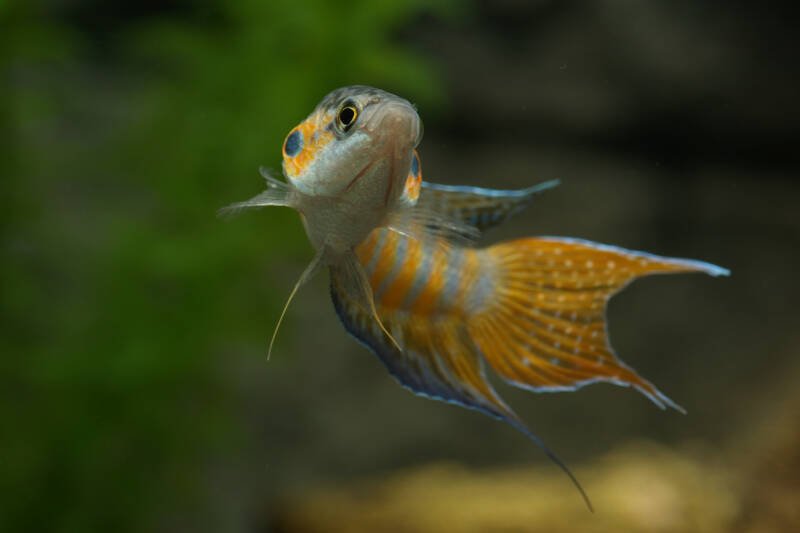
And while they’re half the size of their cousins, their attitude is equivalent – if not BIGGER.
Lifespan
Paradises have an average lifespan of between 8-10 years. That’s assuming they receive top care, of course. As they need pristine water conditions and a healthy diet, they may not live that long.
However, there are a few documented cases of a paradise fish surviving longer than ten years.
Behavior
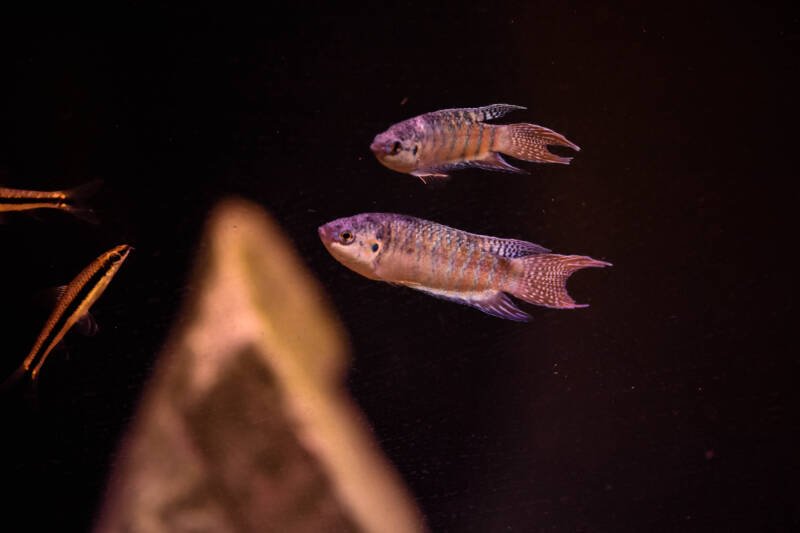
Similar to the aggressive behavior of bettas, paradise fish males should never share the same tank. They immediately engage in fights over territory and any females present.
If you want to keep more than one male, you’ll need a huge tank.
When two males catch sight of each other, you’ll see their colors grow darker. They also extend their fins out from the sides of the body and flare the operculum. The display serves as an intimidation attempt.
If the other male fails to back away, you’ll see them swim at one another and lock their mouths together.
The fighting often leads to injury, and sometimes the wounds can cause permanent damage. This is why it’s better to keep a single male on his own. He WON’T mind.
Females don’t display the same aggressive tendencies. And while you’re okay to keep a male with females, you need to watch them during spawning seasons.
Males WILL aggressively target females to encourage spawning, and the female can suffer injuries.
Most aquarists choose to avoid potential problems by keeping a single paradise fish.
There’s no need to maintain a school with this colorful fish. Most people report their paradise is more active when kept alone, anyway.
Tank Setup
To allow your paradise fish plenty of swimming room – with no risk to their trailing fins – you want to look for a 20-gallon (76 l) tank.
If you plan to keep more than one paradise, add 5 gallons (19 l) for each additional fish. (Unless it’s a male – then DOUBLE the tank size).
You’ll need a sturdy lid that fits the aquarium you choose. Paradises WILL jump.
But the cover serves a more critical function. As labyrinth fish, paradises need to breathe air. And the lid traps humid air at the surface. You don’t want your paradise fish to breathe dry air.
If your fish ends up taking dry air through their labyrinth organ, they can end up developing a respiratory infection. That’s the best-case scenario. At the worst, the delicate membranes within the organ can suffer damage, impairing their ability to breathe.
Water Conditions
In the wild, paradise fish survive in habitats that vary in their water conditions.
And while they’re from tropical and sub-tropical regions, people have found them happily existing in streams at higher elevations where temperatures drop lower.
You CAN consider keeping paradise fish in cold tanks with little problem. Their ideal temperature range is anywhere from 68-82°F (20-27.7°C).
Some aquarists have also found their paradises benefited from a dip in temps during the winter months!
You also have room to play with their pH and water hardness levels.
They’ll tolerate slightly acidic OR slightly alkaline water without a problem (5.8-8.0). Just skip any extremes. And try not to make the change too rapid. The hardness can vary anywhere from 5-30dH.
What CAN’T range is the water quality. They need pristine water to remain healthy. You’ll want to run regular checks to ensure you do not see ANY ammonia, nitrates, or nitrites. T
his is where their flexibility ends, and it’s one of the reasons they’re challenging to care for.
Decorating the Paradise Fish Tank
Paradise fish aren’t the pickiest when it comes to their tank décor. However, they will appreciate an aquarium that matches their native habitat. (You can skip the excess mud and debris, if you’d prefer, though)
Most of the blackwater rivers and streams they inhabit have sandy bottoms. And while they prefer to swim in the top and middle of the tank, you’ll probably want to stick to sand for your substrate choice.
The most important part of the décor is the plants. Paradise fish use them to hide out.
And they will take an occasional nibble. So you’ll want to choose greenery that can handle some abuse. You’re best options include:
- Duckweed
- Dwarf hairgrass
- Guppy grass
- Hornwort
- Java moss
- Salvinia
- Water wisteria.
Paradise Fish in Communities
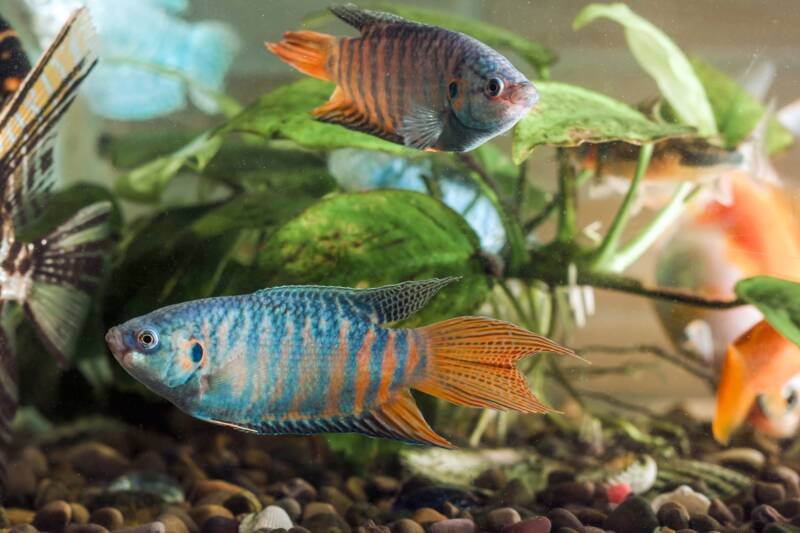
Trying to set up a paradise fish in a community is tricky. They’ll pick a fight with ANY fish their size.
And with smaller species, they’ll set out to secure their spot as the “top fish” in the aquarium. This may lead to injuries. You’ll need to do some careful homework.
Tank Mates
If you want a peaceful community – free from bullying and fear – your best bet is to choose tank mates that are BIGGER than your paradise. That aggressive streak will settle down.
However, you also need to make sure the larger fish are peaceful, so your paradise doesn’t end up stressed.
It’s a careful balance. You don’t want anyone in the community to feel harassed. But there ARE plenty of options that will lead to a beautiful tank. And the best choices include:
- Bala shark
- Blue gourami
- Bristlenose plecostomus
- Clown loach
- Comet goldfish
- Cuckoo catfish
- Danios
- Gold gourami
- Opal gourami
- Red tail shark
- Yoyo loach.
Incompatible Species
Paradise fish are always looking for a fight. And if you attempt to pair them up with other aggressive species – such as bettas or cichlids species – you’ll end up with carnage.
They’ll try to establish dominance. And if they can’t win? They’ll retreat into permanent hiding and starve.
You also need to avoid fish with long, flowing fins – regardless of their size. Plenty of fancy goldfish top paradises in the weight category. But they can’t muster the speed to escape. And they’ll end up getting nipped and harassed.
Some aquarists consider setting up mixed species tanks. You’re going to end up rolling the dice.
Your paradises may leave freshwater shrimp and snails alone. Or they could attempt to add them to the menu as snacks. If you go this route, watch the interactions carefully.
Food and Diet
Paradise fish fall into the omnivore category, and they’re not difficult to please.
However, while they’ll accept anything you offer, you want to tailor their menu to preserve those rainbow scales. And that means an emphasis on protein.
You can opt for live or frozen options. But a high level of protein will help boost the natural colors of your paradises.
They have top favorites to chase down:
- Bloodworms
- Brine shrimp
- Mosquito larvae
- White worms.
That doesn’t mean you want to skip the green side of things, though. If you feel brave, you can make up homemade fish foods to make sure you’re getting a proper balance of protein and veggies.
Paradise fish should get fed twice a day. This prevents strain on their digestive tract and staves off potential issues, such as constipation and bloat.
You only need to offer as much food as they can eat within five minutes – even if they beg for more.
Breeding Paradise Fish: A Tale of Two Tanks
If you want to breed paradise fish, you WILL need separate tanks. This will protect your female paradise and any other fish you may have in your community aquarium.
You may also want to consider a THIRD tank to raise the fry. It depends on your available resources. You’ll want to use a 20-gallon (76 l) tank with the same water conditions as your primary tank.
However, keep the water level lower. You only need around 6-8 inches (15-20 cm) of water. This will help the fry with their development once they hatch.
Male or Female?
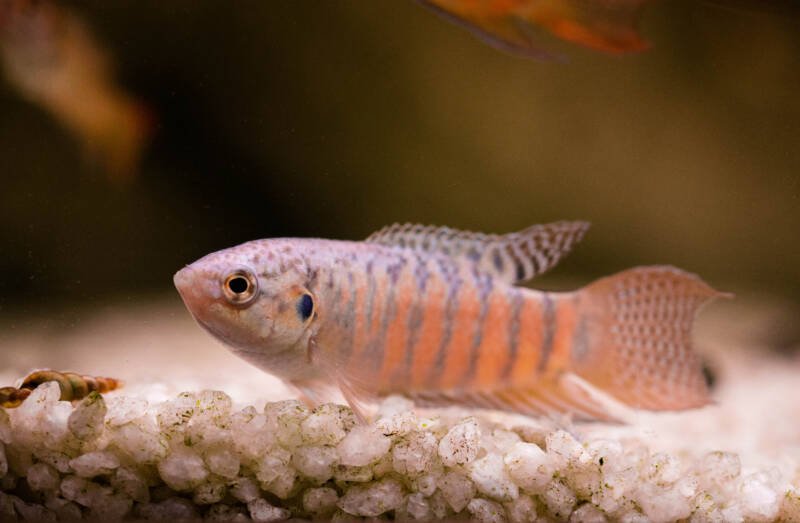
Separating a male and female paradise fish is easy. The males have brighter, more elaborate color patterns. And when you look at the dorsal and anal fins, they trail longer through the water.
Females WILL grow wider, but only when they’re carrying eggs.
Bubble Nests and Male Aggression
As with some other members of the Family Osphronemidae, paradise fish are bubble nesters. Males blow bubbles (coated in fishy saliva) at the surface.
The bubbles stick together and form a nest to attract the female and house the eggs while they develop.
Males can also create bubble nests outside of spawning season – or even without a female around. It’s a sign of contentment.
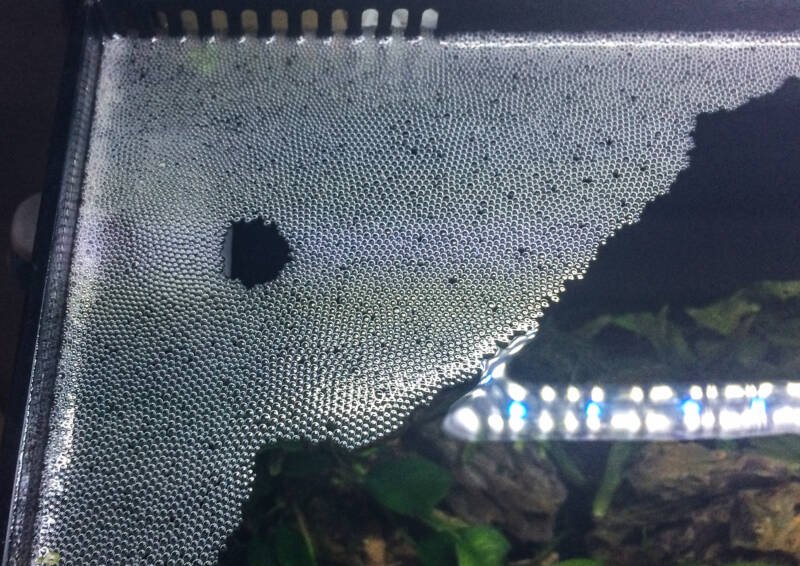
So if you want to encourage breeding, you’ll need to do a little extra work to get things going.
Slowly increase the tank temperatures to 80-84°F (26-29°C). With the male and female SEPARATED, offer her multiple feedings of live protein. This is crucial as she’ll stop eating for two weeks before she’s ready to lay eggs.
Don’t add her to the tank until she’s plump with eggs. Otherwise, the male may kill her in his attempts to spawn.
You’ll see him perform courting displays before wrapping around her. She then releases her eggs into the bubble nest. Remove her from the tank – for her safety.
The male guards the nest. And it’s an essential paternal duty. For the 30-90 hours it takes the eggs to hatch, he won’t eat.
You NEED to allow the male to guard the bubble nest, or he’ll remain aggressive as his hormones won’t have a chance to calm down.
Once the fry hatch, it’s okay to remove the male. If you don’t, he’ll eat them. (He’s a doting parent for only so long)
They’ll absorb their yolk sac for the first couple of days, and then you’ll see them emerge from the bubble nest. They’ll happily eat infusoria and baby brine shrimp for you.
That shallow tank depth is needed to allow the fry to develop their labyrinth organ. If they’re in a deep aquarium, it becomes a struggle for them to reach the surface. The tissues within won’t form properly, and it may compromise them as adults.
Hardiness and Diseases
Paradise fish are healthy and hardy – for the most part. But in tanks with poor water quality, they quickly develop problems. The same goes if you fail to offer them a balanced diet with high-quality ingredients.
Lymphocysistis disease is common in paradises. Aquarists may mistake the tiny growths on the fins for ich.
However, the condition comes from a virus – not a protozoan. It gains a hold in stressed fish. If left untreated, the infection spreads and prevents your fish from swimming.
You’ll also see bacterial issues, such as fin rot. Flowing fins are always a problem. And if you allow any fighting to take place – mainly if you keep more than one paradise male in a tank – the potential for bacteria to get into a wound exists.
Paradise Fish: Are They For You?
For those who admire these feisty rainbows, you can find paradise fish for little more than $5.
They’re popular, and it doesn’t take much trouble to find them in fish stores or even your average chain pet stores.
If you want a more exotic look for your paradise fish, you can also find two genetically engineered varieties.
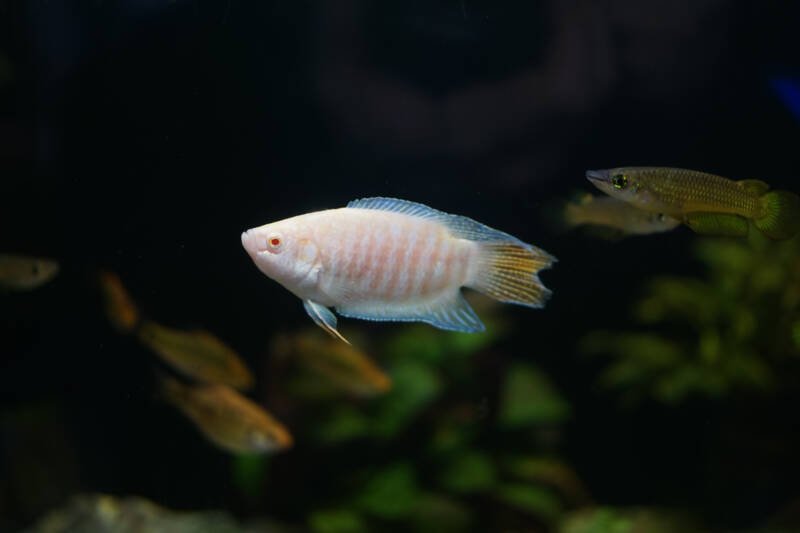
An albino (complete with pink eyes) boasts blue, pink, and white stripes. Meanwhile, the Macropodus hongkongensis (former concolor) variety comes in with a darker color palette without dark bands.
They’re gorgeous fish to watch dart around a freshwater tank. But their aggressive behavior is challenging for people to manage.
As they’ll go after fish of any shape and size, you’ll need to make sure you’re up to the task of keeping them wrangled.
Colorful Bullies Needing Careful Management
Paradise fish live up to their name – at least with their colorful scales.
Their attitudes are another matter. They’re bullies, taking on members of their species and any fish they think they can best.
But if you can handle that pint-sized aggression, they’re worth it!
Have you kept paradise fish? Do you keep them on their own or in a school?
What’s your set-up for breeding them?
Share your stories and questions with us here!